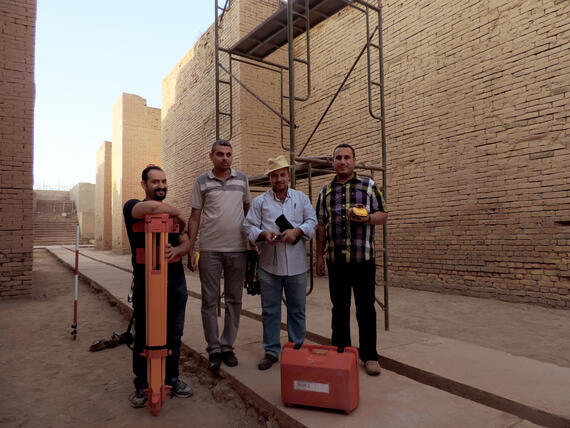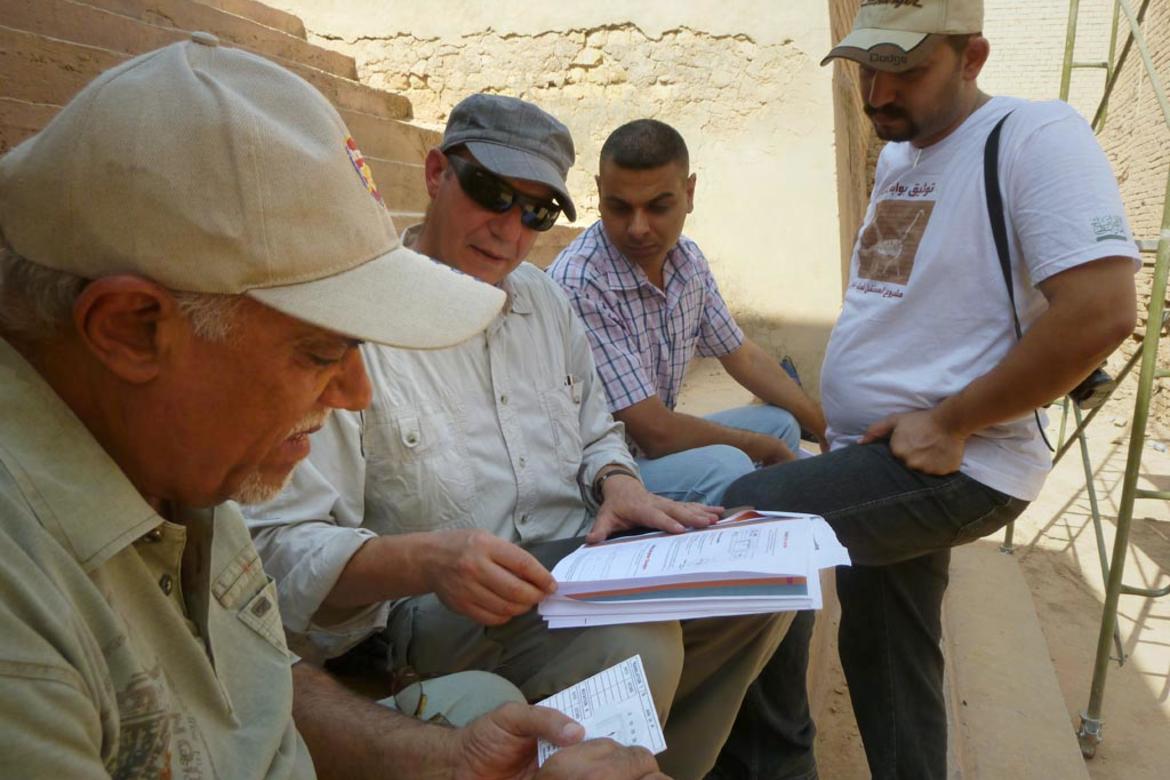Documenting Babylon

Babylon’s main northern entrance, the Ishtar Gate, was the largest and most elaborate of the city’s gateways. Mesopotamian kings, who erected the structure, probably rebuilt it several times and in a later phase added colorful glazed bricks. The Ishtar Gate connected the Northern Palace with the sanctuary of Marduk (the Esagila Temple in the heart of Babylon) and the ziggurat (Tower of Babylon).
The Ishtar Gate was initially excavated by the German Oriental Society (in 1903 and 1910) and the Nebuchadnezzar II-era glazed surface material previously cut away by brick-miners was collected and removed. Robert Koldewey, charged with the expedition, and his workforce of hundreds of villagers, excavated most of the relief fragments found that were later reconstructed in Berlin. The lower levels still in situ at Babylon feature unglazed brick reliefs that presumably continue deep underground. Koldewey attempted a sounding that was blocked by the water table before he could reach the base of the gate’s foundations, but they continued for several meters below the present ground level.
The unglazed gate beneath the colorful decorations was subject to interventions in the late 1950s/early 1960s and later during the Revival of Babylon Project. These efforts mainly addressed site presentation and the damage caused by the high water table that exacerbated masonry decay. Access staircases were added, a drainage and cistern system dug and capped with concrete flooring, and historic masonry in-filled from behind with modern fired bricks.
These inventions only hastened water damage to the monument. The large-scale re-grading of the surrounding landscape funnels water into the Gate. The non-porous concrete pavement, 25cm thick, drives the evaporation process up into the walls and drainage channels rain down the facade, eroding the animal reliefs, many of which have disappeared since the gate was excavated.
Under the direction of the Iraq State Board of Antiquities and Heritage (SBAH) and supported by World Monuments Fund, work began at the Ishtar Gate in 2010 with the compilation of detailed documentation. Through a Kress Foundation grant, World Monuments Fund employed CyArk, a non-profit California-based digital documentation agency, to complete a three-dimensional laser scan of the Ishtar Gate complex.
Since that time at the encouragement of World Monuments Fund and a directive of the Iraq State Board of Antiquities and Heritage through their Babylon Committee, my group of four engineers, Firas Salh Mohammed, Salem Abdel Amir, Nour Diaa, and myself, known as the Babylon Documentation Work Group, has been occupied with documenting in detail the entire structure as a prelude to its conservation. At its offices in Oakland, CyArk provided training for two of us in software for the creation of AutoCAD software plans, elevations, and sections drawings. Since then with World Monuments Fund guidance, the SBAH’s Babylon Documentation Work Group has digitally drawn the Ishtar Gate at the brick-by-brick level; recording not only the monument’s form, but also its condition—from mapping the effects of rising groundwater to identifying cuneiform dedication bricks and graffiti.
But our documentation effort includes not only a digital 3D model and set of AutoCAD drawings. The monument has also undergone detailed photo-documentation, monitoring programs and preparatory studies too, and our work extends to measuring the changing groundwater level, its impact on masonry humidity, their correlation to the nearby Euphrates River, and climatic conditions through a weather station on site. The results of all are providing a detailed picture of how Ishtar Gate is being affected by the elements and human presence.
Although conceived prior to the current crisis in looting and the destruction of antiquities, the Babylon Documentation Work Group’s mission has now become all the more important for Iraq. At the Ishtar Gate a template for improving preservation throughout the country is being fashioned, one where risk management policies comprise comprehensive documentation not only for conservation purposes, but as archival records of a monument at a given point in time.
Special thanks to the U.S. State Department Ambassadors Fund for Cultural Preservation and the U.S. Embassy in Baghdad for their support.
Image top, from left to right: Salem Abdel Amir, Firas Salih Mohammed, Salman Ahmed Soulieman, Nour Diaa



